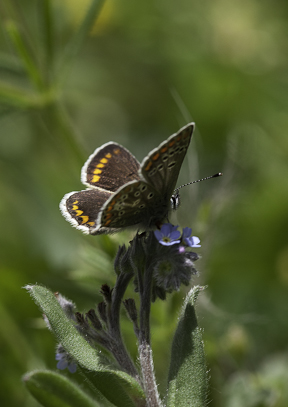Butterflies
Skippers
Whites
Hairstreaks
Blues and Coppers
Admirals
Vannesids
Fritallaries
Browns
Emergence
| Year | First | Second |
| 1976 | 7 July WH | |
| 1977 | 28 May WH | |
| 1978 | 1 June WH | |
| 1979 | 13 June WH | |
| 1980 | 26 May WH | |
| 1981 | 14 June WH | |
| 1982 | 2 June WH | |
| 1983 | 12 June WH | |
| 1984 | 8 June WH | |
| 1985 | ||
| 1986 | ||
| 1987 | 18 June BR | |
| 1988 | ||
| 1989 | 12 June WH | |
| 1990 | ||
| 1991 | ||
| 1992 | ||
| 1993 | ||
| 1994 | ||
| 1995 | ||
| 1996 | ||
| 1997 | ||
| 1998 | ||
| 1999 | ||
| 2000 | ||
| 2001 | ||
| 2002 | ||
| 2003 | ||
| 2004 | ||
| 2005 | ||
| 2006 | ||
| 2007 | 30 Aug BR | |
| 2008 | ||
| 2009 | ||
| 2010 | ||
| 2011 | 7 May BR1 | |
| 2012 | ||
| 2013 | 10 Aug BR | |
| 2014 | 20 May BC | |
| 2015 | 24 Aug | |
| 2016 | ||
| 2017 | ||
| 2018 | ||
| 2019 | 17 Jun FACK | 17 July |
| 2020 | 15 June BC |
Submit Your Records & Comments Here
Butterfly Survey 1976-2020
Brown Argus
Aricia agestis


Habit: The Brown Argus can be common in certain years - successively inhabiting the same small spot of neglected ground. It is something of a shadow in flight and needs close observation as it flits at low level, before coming to rest, slowly turning and opening its wings to the sun.
Field Notes: Superficially the Argus can be confused with the small blue in flight and also second generation female common blues, but distinguished by more sudden movement and grey underwing and stronger topwing markings.
The brown argus is likely to be found in spots, such as: allottments, old gardens, verges and grazed or managed fields - where improvement might have taken place and then left. Seen close to foodplant in almost all cases.
Double brooded in most years .
Larval Foodplant: rock rose
wingspan: 28mm
Status: not particularly under threat, except from the general erosion and tidying of rough disused land on which they breed.
WH - White Hill Shoreham, BC - Bromley Common, BIC-Bickley, Kes - Keston, Ha - Hayes --BN - Bromley North - Ey Eynsford - Orp-Orpington, FACK - Fackenden Down and Bank
Thanks to Howard Walmsley and David Davis, Fred
© Rodney Compton
